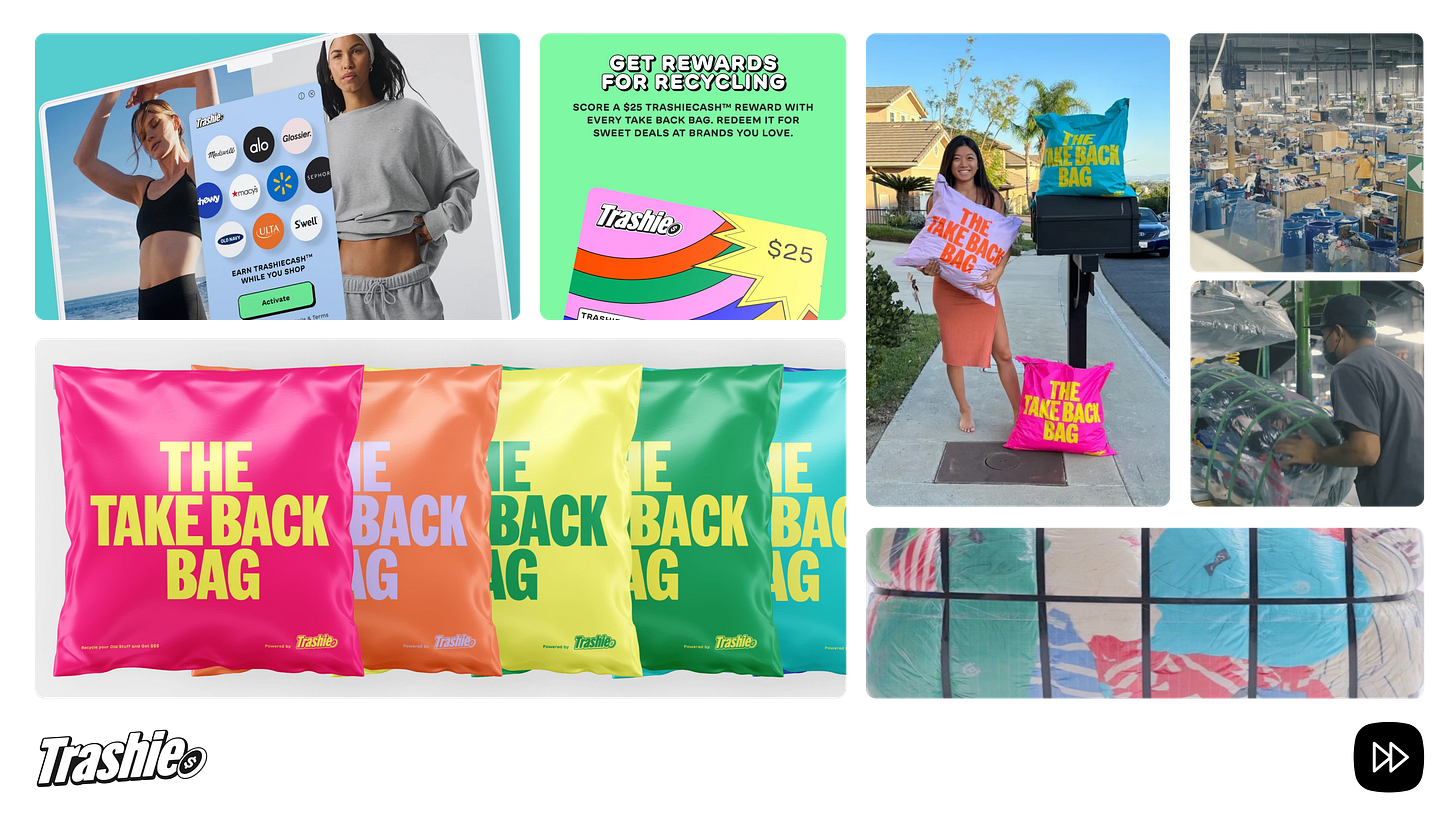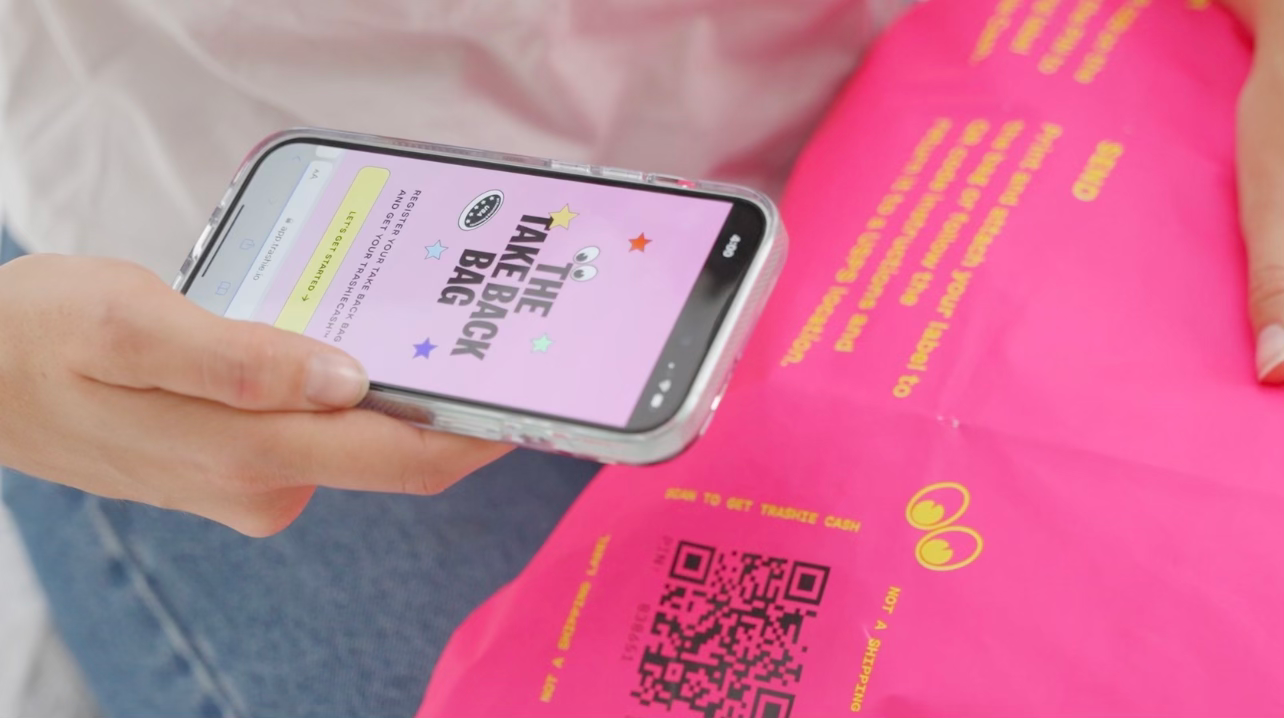Founder Insights #6: Trashie's Circular Fashion Revolution Rewards Recycling
Rewards, convenience, and behavioral design: How a dual-sided platform is transforming textile recycling
Kristy Caylor, founder and CEO of Trashie, has created an innovative business model that tackles two critical challenges in sustainable fashion: making clothing recycling convenient and rewarding consumer sustainable choices.
Recent data reveal a global shift toward faster fashion cycles. To put it concretely, if a garment was typically worn 100 times in 2004, it’s now worn only 55 times in 2024. Annually, customers discard wearable clothes worth a cumulative $500 billion.
Less than 1% of textiles used for clothing are recycled into new garments. Including clothing donations, three out of five garments end up in landfills or are incinerated. At the same time, textile production generates 1.2 billion tons of greenhouse gas emissions annually—more than international flights and maritime shipping combined1.
Through its Take Back Bag program, Trashie has built a comprehensive ecosystem that keeps unwanted clothes and textiles out of the trash. Their advanced North American sorting facility achieved a 90% landfill diversion rate through precision sorting into 253 grades. With impressive customer retention and 5 million pounds of textiles recycled, Trashie is demonstrating the power of technological innovation combined with consumer-centric incentive systems.
Below are Kristy's responses to three key questions, followed by my industry analysis and perspective (marked with "▷▷").
1. Understanding Consumer Priorities in Sustainable Fashion
With your background in luxury fashion and now focusing on circular economy solutions, what's the most surprising insight you've gained about consumer behavior in relation to sustainability and fashion? How has this influenced your business strategy?
Pragmatically, Kristy emphasizes that offering direct value to consumers plays a fundamental role in their decision-making:
I've been working with consumers and sustainability for such a long time: not much surprises me. From a consumer standpoint, the first priority is value - that can be design, product quality, brand experience, financial value. Those attributes typically trump the actual sustainability component of the product.
If the brand or product excels on quality, experience, performance, or design, customers might pay more, but they will not pay more simply because of the sustainable elements. If there is a financial benefit to choosing the sustainable product or service, that is even better.
Understanding the nuances about sustainable fashion can be daunting and sometimes overwhelming - good storytelling and simple messaging is essential and is communicating with authenticity. Honesty is better than perfection. Consumers are busy and distracted so they need things to be easy and convenient.
Looking beyond just fashion, Trashie's model demonstrates that:
outside specific niches, immediate rewards trump long-term environmental benefits in driving behavior change.
Removing friction is more effective than education in scaling sustainable behaviors.
Sustainable solutions must integrate seamlessly with existing consumer habits.
Trashie's dual-reward system —offering store credit for recycling and shopping rewards—represents a new paradigm in circular economy business models. By monetizing both disposal and purchase behaviors, they’ve created a self-reinforcing loop that could be replicated across other consumer categories.
However, while Trashie's rewards system effectively drives recycling behavior, it could incentivize continued consumption through its through its store credit and shopping incentives. Brands like Patagonia encourage longer garment use, but we intuitively understand that the solution lies in reducing consumption. At scale, Trashie’s model could inadvertently accelerate the fast fashion cycle. One way to mitigate this potential risk is to limit earning and spending of store credit to sustainable options only.
2. The Collection Challenge
If you could instantly change one aspect of consumer behavior or industry practice to accelerate the adoption of circular fashion, what would it be and why?
Kristy identifies collection as the critical bottleneck:
We believe solving for collection unlocks a tremendously important bottleneck. We would like to capture as much as the post consumer waste stream as possible and that means working with both consumers and with the industry as a whole.
The textile recycling industry's fundamental challenge is highlighted by a stark statistic: clothing consumption has increased 400% over the last 20 years, while collection and recycling infrastructure has lagged severely behind. Trashie’s precision sorting system (253 grades based on quality, category, seasonality, and material) represents a paradigm shift from traditional recycling methods. While most collection programs blindly export mixed bales, contributing to waste colonialism, Trashie's approach ensures optimal matching of items to end markets.
The company's sophisticated matchmaking system for reuse markets demonstrates deep understanding of global supply-demand dynamics. By timing seasonal clothing shipments to specific regions, they're maximizing the environmental impact of reuse – which can reduce a garment's greenhouse gas emissions by 44% when its wear cycle is doubled.
Their commitment to fiber-to-fiber recycling innovation, despite its current limitations, shows long-term strategic thinking. By building relationships with leading recyclers like Renewcell and Ambercycle, and developing specialized collection streams, they're helping create the infrastructure needed for true circularity.
3. Measuring Success in Circular Fashion
What's one unconventional metric or data point you track at Trashie that you believe gives you a competitive edge in driving towards a more circular fashion economy?
Trashie focuses intensely on customer engagement and impact metrics:
Not necessarily unconventional, but we view repeat behavior as the most important metric. We are trying to create a new habit and our success is measured by whether people keep coming back for more. We see 94% annual repeat rates, have sold over 600K Take Back Bags in the last 12 months and have recycled 5M Lbs of textiles.
The repeat rate suggests that once consumers experience a well-designed sustainable solution, they're highly likely to incorporate it into their regular routines. This challenges the common belief that sustainable behaviors require ongoing education and motivation.
The integration of shopping rewards through their Chrome extension demonstrates how sustainability initiatives can leverage existing consumer behaviors rather than trying to create new ones. This "path of least resistance" approach could revolutionize how we think about driving sustainable behaviors.
The focus on repeat behavior rather than total volume understands the unit economics in the circular economy. By creating predictable waste streams through habitual use, Trashie can better optimize their sorting and distribution infrastructure.
I invested in Trashie through Alumni Ventures and appreciate the company's pragmatic approach to solving the collection challenge as it addresses a critical bottleneck in creating a circular fashion economy. Their ability to process vast amounts of textile waste weekly demonstrates that combining consumer convenience with industrial-scale operations can drive meaningful change.
The key will be carefully managing growth to ensure that increased recycling capacity genuinely reduces fashion's environmental impact rather than just enabling faster consumption cycles. As major brands like H&M commit to using 100% recycled or sustainably sourced materials by 2030, Trashie's infrastructure and technology could become increasingly valuable in enabling this industry transformation.




